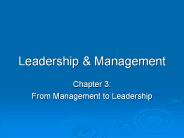LEADERSHIP - PowerPoint PPT Presentation
1 / 25
Title:
LEADERSHIP
Description:
LEADERSHIP Submitted to : Mr.Hussain Khorasani Submitted by : Taqdees Tahir (BB/852) ... forward looking, and inspiring. LEADERSHIP STYLES The leadership styles are: ... – PowerPoint PPT presentation
Number of Views:625
Avg rating:5.0/5.0
Title: LEADERSHIP
1
LEADERSHIP
- Submitted to
- Mr.Hussain Khorasani
- Submitted by
- Taqdees Tahir (BB/852)
- Huma Siddiqui (BB/783)
- Muhammad Shahid (BB/805)
- Nasir Saleem (BB/809)
- Omair Ahsan (BB/808)
2
Leadership
- Leadership can be defined as
- The art or process of influencing people
so that they will strive willingly and
enthusiastically toward the achievement of group
goals.
3
TYPES OF LEADER IN ORGANIZATION
- FORMAL LEADER
- INFORMAL LEADER
4
LEADERSHIP BASIC
- Leadership has been defined as
- An integral part of the group process.
- As an influence process,
- As the initiation of structure, and
- As the instrument of goal achievement.
5
- Group phenomenon
- Influence
- Goal directed
- Hierarchy
6
INGREDIENTS OF LEADERSHIP
- The ability to use power effectively and in a
responsible manner - The ability to comprehend that human beings have
different motivation force at different times and
in different situations - The ability to inspire
- The ability to act in a manner that will develop
a climate conductive to responding to and
arousing motivations
7
THREE APPROACHES TO UNDERSTANDING LEADERSHIP
- The three general approaches have been used to
understand leadership are - Trait Approach
- Behavior Approach
- Contingency Approach
8
- 1) EARLY TRAIT APPROACH
- From 1900s to 1940s, most leadership studies
focused on identifying leadership characteristics
or traits. - Trait approach aimed at identifying individual
characteristics such as demographic factor or
personality traits. - 2) BEHAVIOR APPROACH
- Leadership behavior concerned with defining and
organizing the task to help followers achieve the
goals.
9
- Leadership behavior that aimed at creating mutual
trust and respect with followers. - 3)CONTIGENCY APPROACH
- Strong-willed and domineering more effective then
one who is soft-spoken and allows participation.
10
LEADERSHIP TRAITS
- Theorists explain leadership ability in terms of
inherent characteristics or qualities that people
posses to different degrees. - Employees provided four traits in over 50 of
their responseshonest, competent, forward
looking, and inspiring.
11
RANKING CHARACTERISTICS PERCENT
1 Honest 88
2 Forward-looking 75
3 Inspiring 68
4 Competent 63
5 Fair-minded 49
6 Supportive 41
7 Broad minded 40
8 Intelligent 40
9 Courageous 35
10 Dependable 32
11 Straightforward 29
12 Cooperative 28
12
13 Imaginative 28
14 Caring 23
15 Determined 17
16 Ambitious 13
17 Loyal 13
18 Mature 13
19 Self-controlled 11
20 Independent 5
13
LEADERSHIP STYLES
- The leadership styles are
- Autocratic
- Participative or democratic
- Free-rein
- 1) AUTOCRATIC LEADERSHIP
- The autocratic leader command and expect
complains is dogmatic and positive, and leads by
the ability to withhold or give reward and
punishment.
14
- 2) DEMOCRATIC OR PARTICIPATIVE
LEADERSHIP - The democratic or participative, leaders consults
with subordinates on proposed action and
decision. - 3)FREE-REIN LEADERSHIP
- The free-rein leader uses his or her power very
little, if at all, giving subordinate a high
degree of independence in their operations.
15
AUTOCRATIC LEADER
FOLLOWER
FOLLOWER
FOLLOWER
DEMOCRATIC LEADER
FOLLOWER
FOLLOWER
FOLLOWER
FREE-REIN LEADER
FOLLOWER
FOLLOWER
FOLLOWER
THE FLOW OF INFLUENCE WITH THREE LEADERSHIP STYLES
16
CONTINGENCY THEORY OF LEADERSHIP
- Fred Fiedler developed the first comprehensive
leadership contingency model in the 1960s. - basic premise is that the match between the
leader styles and the leadership situation. - The theory holds that people become leaders not
only because the attributes of their
personalities but also because of their
situational factors and the interaction between
leaders and group members.
17
- The following are the three situational factors
- 1)Position power
- 2)Task structure
- 3)Leader-member relation
- 1)POSITION POWER
- contingency model, refers to the leaders official
power and influence over subordinates to hire,
fire, reward, or punish.
18
- 2)TASK STRUCTURE
- It refers to the degree of clarity a task,
- the quality of performance can be more easily
controlled and group member can be held more
definitely responsible for performance. - 3)LEADER-MEMBER RELATION
- It refers to cohesion of the group and the
quality of interaction between the leader and
follower and among group member. - Leadership performance depends as much on the
organization as it depends on the leaders own
attribute.
19
THE PATH-GOAL THEORY
- The path-goal theory suggests that the main
function of the leader is to clarify and set
goals with subordinates, help them find the best
path for achieving the goals, and remove
obstacles. - Leader behavior categories into four groups
- 1) Supportive leadership
- 2) Participative leadership
- 3) Instrumental leadership
- 4) Achievement-oriented leadership
20
- 1) SUPPORTIVE LEADERSHIP
- Supportive leadership behavior gives
consideration to the need of subordinate, shows a
concern for their well being, and creates a
pleasant organizational climate. - 2) PARTICIPATIVE LEADERSHIP
- Participative leadership allows subordinates to
influence the decision of their superiors and can
result in increased motivation
21
- 3)INSTRUMENTAL LEADERSHIP
- Instrumental leadership gives subordinates rather
specific guidance and clarify that is expected of
them this includes aspect of planning,
organizing, coordinating, and controlling by the
leader. - 4)ACHIEVEMENT-ORIENTED LEADERSHIP
- Achievement-oriented leadership involved setting
challenging goals, seeking improvement of
performance.
22
LEADER MEMBER EXCHANGE THEORY
- The leader member exchange theory describes the
different kinds of relationships b/w a leader and
a follower and describes what the leader and the
follower give to and receive back from the
relationship. - This model focuses on the leader-follower
dyad---(a dyad is two individuals regarded as a
pair. - The leader develops with the subordinate a
special relationship characterized by mutual
trust,commitment and involvement.
23
- The relationship b/w a leader and subordinates
can be classified as in-group or out-group
relationship. - Research suggesst that it is desireable for
leaders to develop special relationships with
their subordinates,for subordinates who are in
the in-group are loyal to their leaders and
perform a high level then the subordinates in the
out-group
24
NEW TOPICS IN LEADERSHIP RESEARCH
- TRANSFORMATIONAL LEADERSHIP
- CHARISMATIC LEADER
- LEADER MOOD
- GENDER AND LEADERSHIP
25
CONCLUSION
- Leadership required creating shared visions of
future objectives, determining how they can be
obtained, convincing other to join the effort to
succeed.































